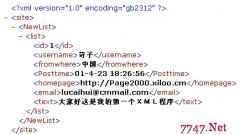ASP中遍历和操作Application对象的集合(1)
来源:网络整理 责任编辑:admin 发表时间:2013-07-01 14:49 点击:次
为了能够正常使用,必须把它们放到服务器上的一个虚拟应用程序内,并且把所提供的global.asa文件放到该应用程序的根目录中。最简单的办法是把global.asa文件放到缺省Web网站的根目录(缺省情况下是C:/InetPub/WWWRoot)中。
对任何已有的global.asa文件重命名是一个好办法,可以在以后对该文件进行恢复。
1. 显示Application集合的内容
ASPCounter对象是StaticObjects集合的一个成员(通过<OBJECT>元素进行定义),但是其余部份(由Server.CreateObject实例化)是Contents集合的成员。
可以看到使用global.asa例子网页放到这些集合中的值,这在前面已经看到:
<!-- Declare instance of the ASPCounter component with
application-level scope //-->
<OBJECT ID=”ASPCounter” RUNAT=”Server” SCOPE=”Applicatoin”
PROGID=”MSWC.Counters”>
</OBJECT>
...
...
<SCRIPT LANGUAGE=”VBScript” RUNAT=”Server”>
Sub Application_onStart()
‘Create an instance of an ADO Connection with application-level scope
Set Application(“ADOConnection”) = Server.CreateObject(“ADODB.Connection”)
Dim varArray(3) ‘Create a Variant array and fill it
varArray(0) = “This is a”
varArray(1) = “Variant array”
varArray(2) = “stored in the”
varArray(3) = “Application object”
Application(“Variant_Array”) = varArray ‘Store it in thd Application
Application(“Start_Time”) = CStr(Now) ‘Store the date/time as a string
Application(“Visit_Count”) = 0 ‘Set counter variable to zero
End Sub
...
...
</SCRIPT>
(1) 遍历Contents集合的代码
为了遍历Contents集合,可使用一个For Each ... Next结构。集合中的每一项可以是一个简单的Variant类型变量、一个Variant数组或者一个对象的引用。因为需要对每种类型的值进行不同的处理,所以就不得不对每一个进行检查来判别其类型。
在VBScript中可使用VarType函数完成这个工作。这里使用IsObject和IsArray函数代替:
For Each objItem in Application.Contents
If IsObject(Application.Contents(objItem)) Then
Response.Write “Object reference: ‘” & objItem & “’
”
ElseIf IsArray(Application.Contents(objItem)) Then
Response.Write “Array: ‘” & objItem & “’ contents are:
”
VarArray = Application.Contents(objItem)
‘Note: the following only works with a one-dimensional array
For intLoop = 0 To UBound(varArray)
Response.Write “ Index(“ & intLoop & “) = “ & _
VarArray(intLoop) & “
”
Next
Else
Response.Write “Variable: ‘” & objItem & “’ = “ _
& Application.Contents(objItem) & “
”
End If
Next
注意程序如何从Application对象检索该数组。将其分配给一个局部(Variant)变量,使用下面的语句:
varArray = Application.Contents(objItem)
使用UBound函数可以查找出数组的大小(元素的数量),这个值可以作为遍历的终止条件:
For intLoop = 0 UBound(varArray)
这个例子是一维数组,并将只显示这样的一个数组的内容。可根据需要编辑代码以处理多维数组,例如:
For intLoop = 0 To UBound(varArray)
IntNumberOfDimensions = UBound(varArray, 1)
For intDimension = 0 To intNumberOfDimensions
Response.Write “ Index(“ & intLoop &
对任何已有的global.asa文件重命名是一个好办法,可以在以后对该文件进行恢复。
1. 显示Application集合的内容
ASPCounter对象是StaticObjects集合的一个成员(通过<OBJECT>元素进行定义),但是其余部份(由Server.CreateObject实例化)是Contents集合的成员。
可以看到使用global.asa例子网页放到这些集合中的值,这在前面已经看到:
<!-- Declare instance of the ASPCounter component with
application-level scope //-->
<OBJECT ID=”ASPCounter” RUNAT=”Server” SCOPE=”Applicatoin”
PROGID=”MSWC.Counters”>
</OBJECT>
...
...
<SCRIPT LANGUAGE=”VBScript” RUNAT=”Server”>
Sub Application_onStart()
‘Create an instance of an ADO Connection with application-level scope
Set Application(“ADOConnection”) = Server.CreateObject(“ADODB.Connection”)
Dim varArray(3) ‘Create a Variant array and fill it
varArray(0) = “This is a”
varArray(1) = “Variant array”
varArray(2) = “stored in the”
varArray(3) = “Application object”
Application(“Variant_Array”) = varArray ‘Store it in thd Application
Application(“Start_Time”) = CStr(Now) ‘Store the date/time as a string
Application(“Visit_Count”) = 0 ‘Set counter variable to zero
End Sub
...
...
</SCRIPT>
(1) 遍历Contents集合的代码
为了遍历Contents集合,可使用一个For Each ... Next结构。集合中的每一项可以是一个简单的Variant类型变量、一个Variant数组或者一个对象的引用。因为需要对每种类型的值进行不同的处理,所以就不得不对每一个进行检查来判别其类型。
在VBScript中可使用VarType函数完成这个工作。这里使用IsObject和IsArray函数代替:
For Each objItem in Application.Contents
If IsObject(Application.Contents(objItem)) Then
Response.Write “Object reference: ‘” & objItem & “’
”
ElseIf IsArray(Application.Contents(objItem)) Then
Response.Write “Array: ‘” & objItem & “’ contents are:
”
VarArray = Application.Contents(objItem)
‘Note: the following only works with a one-dimensional array
For intLoop = 0 To UBound(varArray)
Response.Write “ Index(“ & intLoop & “) = “ & _
VarArray(intLoop) & “
”
Next
Else
Response.Write “Variable: ‘” & objItem & “’ = “ _
& Application.Contents(objItem) & “
”
End If
Next
注意程序如何从Application对象检索该数组。将其分配给一个局部(Variant)变量,使用下面的语句:
varArray = Application.Contents(objItem)
使用UBound函数可以查找出数组的大小(元素的数量),这个值可以作为遍历的终止条件:
For intLoop = 0 UBound(varArray)
这个例子是一维数组,并将只显示这样的一个数组的内容。可根据需要编辑代码以处理多维数组,例如:
For intLoop = 0 To UBound(varArray)
IntNumberOfDimensions = UBound(varArray, 1)
For intDimension = 0 To intNumberOfDimensions
Response.Write “ Index(“ & intLoop &
相关新闻>>
最新推荐更多>>>
- 发表评论
-
- 最新评论 进入详细评论页>>


